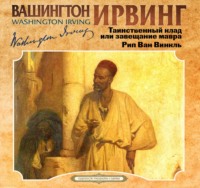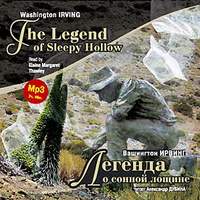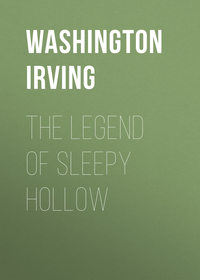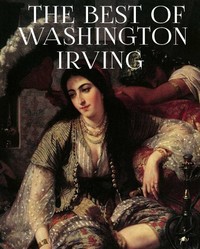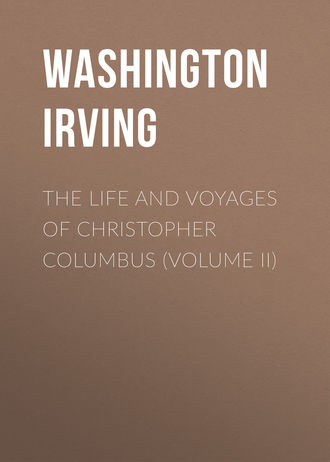 полная версия
полная версияThe Life and Voyages of Christopher Columbus (Volume II)
The account of this curious feast is given by Ramusio, on traditional authority, having heard it many times related by the illustrious Gasparo Malipiero, a very ancient gentleman, and a senator, of unquestionable veracity, who had it from his father, who had it from his grandfather, and so on up to the fountain-head.
When the fame of this banquet and of the wealth of the travelers came to be divulged throughout Venice, all the city, noble and simple, crowded to do honor to the extraordinary merit of the Polos. Maffeo, who was the eldest, was admitted to the dignity of the magistracy. The youth of the city came every day to visit and converse with Marco Polo, who was extremely amiable and communicative. They were insatiable in their inquiries about Cathay and the Grand Khan, which he answered with great courtesy, giving details with which they were vastly delighted, and, as he always spoke of the wealth of the Grand Khan in round numbers, they gave him the name of Messer Marco Milioni.
Some months after their return, Lampa Doria, commander of the Genoese navy, appeared in the vicinity of the island of Curzola with seventy galleys. Andrea Dandolo, the Venetian admiral, was sent against him. Marco Polo commanded a galley of the fleet. His usual good fortune deserted him. Advancing the first in the line with his galley, and not being properly seconded, he was taken prisoner, thrown in irons, and carried to Genoa. Here he was detained for a long time in prison, and all offers of ransom rejected. His imprisonment gave great uneasiness to his father and uncle, fearing that he might never return. Seeing themselves in this unhappy state, with so much treasure and no heirs, they consulted together. They were both very old men; but Nicolo, observes Ramusio, was of a galliard complexion; it was determined he should take a wife. He did so; and, to the wonder of his friends, in four years had three children.
In the meanwhile, the fame of Marco Polo's travels had circulated in Genoa. His prison was daily crowded with nobility, and he was supplied with every thing that could cheer him in his confinement. A Genoese gentleman, who visited him every day, at length prevailed upon him to write an account of what he had seen. He had his papers and journals sent to him from Venice, and, with the assistance of his friend, or, as some will have it, his fellow-prisoner, produced the work which afterwards made such noise throughout the world.
The merit of Marco Polo at length procured him his liberty. He returned to Venice, where he found his father with a house full of children. He took it in good part, followed the old man's example, married, and had two daughters, Moretta and Fantina. The date of the death of Marco Polo is unknown; he is supposed to have been, at the time, about seventy years of age. On his death-bed he is said to have been exhorted by his friends to retract what he had published, or, at least, to disavow those parts commonly regarded as fictions. He replied indignantly that so far from having exaggerated, he had not told one half of the extraordinary things of which he had been an eye-witness.
Marco Polo died without male issue. Of the three sons of his father by the second marriage, one only had children, viz. five sons and one daughter. The sons died without leaving issue; the daughter inherited all her father's wealth, and married into the noble and distinguished house of Trevesino. Thus the male line of the Polos ceased in 1417, and the family name was extinguished.
Such are the principal particulars known of Marco Polo; a man whose travels for a long time made a great noise in Europe, and will be found to have had a great effect on modern discovery. His splendid account of the extent, wealth, and population of the Tartar territories filled every one with admiration. The possibility of bringing all those regions under the dominion of the church, and rendering the Grand Khan an obedient vassal to the holy chair, was for a long time a favorite topic among the enthusiastic missionaries of Christendom, and there were many saints-errant who undertook to effect the conversion of this magnificent infidel.
Even at the distance of two centuries, when the enterprises for the discovery of the new route to India had set all the warm heads of Europe madding about these remote regions of the East, the conversion of the Grand Khan became again a popular theme; and it was too speculative and romantic an enterprise not to catch the vivid imagination of Columbus. In all his voyages, he will be found continually to be seeking after the territories of the Grand Khan, and even after his last expedition, when nearly worn out by age, hardships, and infirmities, he offered, in a letter to the Spanish monarchs, written from a bed of sickness, to conduct any missionary to the territories of the Tartar emperor, who would undertake his conversion.
No. XXI
The Work of Marco PoloThe work of Marco Polo is stated by some to have been originally written in Latin, 339 though the most probable opinion is that it was written in the Venetian dialect of the Italian. Copies of it in manuscript were multiplied and rapidly circulated; translations were made into various languages, until the invention of printing enabled it to be widely diffused throughout Europe. In the course of these translations and successive editions, the original text, according to Purchas, has been much vitiated, and it is probable many extravagances in numbers and measurements with which Marco Polo is charged may be the errors of translators and printers.
When the work first appeared, it was considered by some as made up of fictions and extravagances, and Vossius assures us that even after the death of Marco Polo he continued to be a subject of ridicule among the light and unthinking, insomuch that he was frequently personated at masquerades by some wit or droll, who, in his feigned character, related all kinds of extravagant fables and adventures. His work, however, excited great attention among thinking men, containing evidently a fund of information concerning vast and splendid countries, before unknown to the European world. Vossius assures us that it was at one time highly esteemed by the learned. Francis Pepin, author of the Brandenburgh version, styles Polo a man commendable for his piety, prudence, and fidelity. Athanasius Kircher, in his account of China, says that none of the ancients have described the kingdoms of the remote East with more exactness. Various other learned men of past times have borne testimony to his character, and most of the substantial parts of his work have been authenticated by subsequent travelers. The most able and ample vindication of Marco Polo, however, is to be found in the English translation of his work, with copious notes and commentaries, by William Marsden, F. R. S. He has diligently discriminated between what Marco Polo relates from his own observation, and what he relates as gathered from others; he points out the errors that have arisen from misinterpretations, omissions, or interpretations of translators, and he claims all proper allowance for the superstitious coloring of parts of the narrative from the belief, prevalent among the most wise and learned of his day, in miracles and magic. After perusing the work of Mr. Marsden, the character of Marco Polo rises in the estimation of the reader. It is evident that his narration, as far as related from his own observations, is correct, and that he had really traversed a great part of Tartary and China, and navigated in the Indian seas. Some of the countries and many of the islands, however, are evidently described from accounts given by others, and in these accounts are generally found the fables which have excited incredulity and ridicule. As he composed his work after his return home, partly from memory and partly from memorandums, he was liable to confuse what he had heard with what he had seen, and thus to give undue weight to many fables and exaggerations which he had received from others.
Much had been said of a map brought from Cathay by Marco Polo, which was conserved in the convent of San Michale de Murano in the vicinity of Venice, and in which the Cape of Good Hope and the island of Madagascar were indicated; countries which the Portuguese claim the merit of having discovered two centuries afterwards. It has been suggested also that Columbus had visited the convent and examined this map, whence he derived some of his ideas concerning the coast of India. According to Ramusio, however, who had been at the convent, and was well acquainted with the prior, the map preserved there was one copied by a friar from the original one of Marco Polo, and many alterations and additions had since been made by other hands, so that for a long time it lost all credit with judicious people, until on comparing it with the work of Marco Polo it was found in the main to agree with his descriptions. 340 The Cape of Good Hope was doubtless among the additions made subsequent to the discoveries of the Portuguese. 341 Columbus makes no mention of this map, which he most probably would have done had he seen it. He seems to have been entirely guided by the one furnished by Paulo Toscanelli, and which was apparently projected after the original map, or after the descriptions of Marco Polo, and the maps of Ptolemy.
When the attention of the world was turned towards the remote parts of Asia in the 15th century, and the Portuguese were making their attempts to circumnavigate Africa, the narration of Marco Polo again rose to notice. This, with the travels of Nicolo le Comte, the Venetian, and of Hieronimo da San Stefano, a Genoese, are said to have been the principal lights by which the Portuguese guided themselves in their voyages. 342
Above all, the influence which the work of Marco Polo had over the mind of Columbus, gives it particular interest and importance. It was evidently an oracular work with him. He frequently quotes it, and on his voyages, supposing himself to be on the Asiatic coast, he is continually endeavoring to discover the islands and main-lands described in it, and to find the famous Cipango.
It is proper, therefore, to specify some of those places, and the manner in which they are described by a Venetian traveler, that the reader may more fully understand the anticipations which were haunting the mind of Columbus in his voyages among the West Indian islands, and along the coast of Terra Firma.
The winter residence of the Great Khan, according to Marco Polo, was in the city of Cambalu, or Kanbalu, (since ascertained to be Pekin,) in the province of Cathay. This city, he says, was twenty-four miles square, and admirably built. It was impossible, according to Marco Polo, to describe the vast amount and variety of merchandise and manufactures brought there; it would seem they were enough to furnish the universe. "Here are to be seen in wonderful abundance the precious stones, the pearls, the silks, and the diverse perfumes of the East; scarce a day passes that there does not arrive nearly a thousand cars laden with silk, of which they make admirable stuffs in this city."
The palace of the Great Khan is magnificently built, and four miles in circuit. It is rather a group of palaces. In the interior it is resplendent with gold and silver; and in it are guarded the precious vases and jewels of the sovereign. All the appointments of the Khan for war, for the chase, for various festivities, are described in gorgeous terms. But though Marco Polo is magnificent in his description of the provinces of Cathay, and its imperial city of Cambalu, he outdoes himself when he comes to describe the province of Mangi. This province is supposed to be the southern part of China. It contains, he says, twelve hundred cities. The capital, Quinsai (supposed to be the city of Hang-cheu), was twenty-five miles from the sea, but communicated by a river with a port situated on the seacoast, and had great trade with India.
The name Quinsai, according to Marco Polo, signifies the city of heaven; he says he has been in it and examined it diligently, and affirms it to be the largest in the world; and so undoubtedly it is if the measurement of the traveler is to be taken literally, for he declares that it is one hundred miles in circuit. This seeming exaggeration has been explained by supposing him to mean Chinese miles or li, which are to the Italian miles in the proportion of three to eight; and Mr. Marsden observes that the walls even of the modern city, the limits of which have been considerably contracted, are estimated by travelers at sixty li. The ancient city has evidently been of immense extent, and as Marco Polo could not be supposed to have measured the walls himself, he has probably taken the loose and incorrect estimates of the inhabitants. He describes it also as built upon little islands like Venice, and has twelve thousand stone bridges, 343 the arches of which are so high that the largest vessels can pass under them without lowering their masts. It has, he affirms, three thousand baths, and six hundred thousand families, including domestics. It abounds with magnificent houses, and has a lake thirty miles in circuit within its walls, on the banks of which are superb palaces of people of rank. 344 The inhabitants of Qninsai are very voluptuous, and indulge in all kinds of luxuries and delights, particularly the women, who are extremely beautiful. There are many merchants and artisans, but the masters do not work, they employ servants to do all their labor. The province of Mangi was conquered by the Great Khan, who divided it into nine kingdoms, appointing to each a tributary king. He drew from it an immense revenue, for the country abounded in gold, silver, silks, sugar, spices, and perfumes.
Zipangu, Zifangri, or Cipango.
Fifteen hundred miles from the shores of Mangi, according to Marco Polo, lay the great island of Zipangu, by some written Zipangri, and by Columbus Cipango. 345 Marco Polo describes it as abounding in gold, which, however, the king seldom permits to be transported out of the island. – The king has a magnificent palace covered with plates of gold, as in other countries the palaces are covered with sheets of lead or copper. The halls and chambers are likewise covered with gold, the windows adorned with it, sometimes in plates of the thickness of two fingers. The island also produces vast quantities of the largest and finest pearls, together with a variety of precious stones; so that, in fact, it abounds in riches. The Great Khan made several attempts to conquer this island, but in vain; which is not to be wondered at, if it be true what Marco Polo relates, that the inhabitants had certain stones of a charmed virtue inserted between the skin and the flesh of their right arms, which, through the power of diabolical enchantments, rendered them invulnerable. This island was an object of diligent search to Columbus.
About the island of Zipangu or Cipango, and between it and the coast of Mangi, the sea, according to Marco Polo, is studded with small islands to the number of seven thousand four hundred and forty, of which the greater part are inhabited. There is not one which does not produce odoriferous trees and perfumes in abundance Columbus thought himself at one time in the midst of these islands.
These are the principal places described by Marco Polo, which occur in the letters and journals of Columbus. The island of Cipango was the first land he expected to make, and he intended to visit afterwards the province of Mangi, and to seek the Great Khan in his city of Cambalu, in the province of Cathay. Unless the reader can bear in mind these sumptuous descriptions of Marco Polo, of countries teeming with wealth, and cities where the very domes and palaces flamed with gold, he will have but a faint idea of the splendid anticipations which filled the imagination of Columbus when he discovered, as he supposed, the extremity of Asia. It was his confident expectation of soon arriving at these countries, and realizing the accounts of the Venetian, that induced him to hold forth those promises of immediate wealth to the sovereigns, which caused so much disappointment, and brought upon him the frequent reproach of exciting false hopes and indulging in willful exaggeration.
No. XXII
Sir John MandevilleNext to Marco Polo, the travels of Sir John Mandeville, and his account of the territories of the Great Khan along the coast of Asia, seem to have been treasured up in the mind of Columbus.
Mandeville was born in the city of St. Albans. He was devoted to study from his earliest childhood, and, after finishing his general education, applied himself to medicine. Having a great desire to see the remotest parts of the earth, then known, that is to say, Asia and Africa, and above all, to visit the Holy Land, he left England in 1332, and passing through France embarked at Marseilles. According to his own account, he visited Turkey, Armenia, Egypt, Upper and Lower Lybia, Syria, Persia, Chaldea, Ethiopia, Tartary, Amazonia, and the Indies, residing in their principal cities. But most he says he delighted in the Holy Land, where he remained for a long time, examining it with the greatest minuteness, and endeavoring to follow all the traces of our Saviour. After an absence of thirty-four years he returned to England, but found himself forgotten and unknown by the greater part of his countrymen, and a stranger in his native place. He wrote a history of his travels in three languages, English, French, and Latin, for he was master of many tongues. He addressed his work to Edward III. His wanderings do not seem to have made him either pleased with the world at large, or contented with his home. He railed at the age, saying that there was no more virtue extant; that the church was ruined; error prevalent among the clergy; simony upon the throne; and, in a word, that the devil reigned triumphant. He soon returned to the continent, and died at Liege in 1372. He was buried in the abbey of the Gulielmites, in the suburbs of that city, where Ortelius, in his Itinerarium Belgiæ, says that he saw his monument, on which was the effigy, in stone, of a man with a forked beard and his hands raised towards his head (probably folded as in prayer, according to the manner of old tombs) and a lion at his feet. There was an inscription stating his name, quality, and calling, (viz. professor of medicine,) that he was very pious, very learned, and very charitable to the poor, and that after having traveled over the whole world he had died at Liege. The people of the convent showed also his spurs, and the housings of the horses which he had ridden in his travels.
The descriptions given by Mandeville of the Grand Khan, of the province of Cathay, and the city of Cambalu, are no less splendid than those of Marco Polo. The royal palace was more than two leagues in circumference. The grand hall had twenty-four columns of copper and gold. There were more than three hundred thousand men occupied and living in and about the palace, of which more than one hundred thousand were employed in taking care of ten thousand elephants and of a vast variety of other animals, birds of prey, falcons, parrots, and paroquets. On days of festivals there were even twice the number of men employed. The title of this potentate in his letters was "Khan, the son of God, exalted possessor of all the earth, master of those who are masters of others." On his seal was engraved, "God reigns in heaven, Khan upon earth."
Mandeville has become proverbial for indulging in a traveler's exaggerations; yet his accounts of the countries which he visited have been found far more veracious than had been imagined. His descriptions of Cathay, and the wealthy province of Mangi, agreeing with those of Marco Polo, had great authority with Columbus.
No. XXIII
The ZonesThe zones were imaginary bands or circles in the heavens producing an effect of climate on corresponding belts on the globe of the earth. The polar circles and the tropics mark these divisions.
The central region, lying beneath the track of the sun, was termed the torrid zone; the two regions between the tropics and the polar circles were termed the temperate zones, and the remaining parts, between the porlar circles and the poles, the frigid zones.
The frozen regions near the poles were considered uninhabitable and unnavigable on account of the extreme cold. The burning zone, or rather the central part of it, immediately about the equator, was considered uninhabitable, unproductive, and impassable in consequence of the excessive heat. The temperate zones, lying between them, were supposed to be fertile and salubrious, and suited to the purposes of life.
The globe was divided into two hemispheres by the equator, an imaginary line encircling it at equal distance from the poles. The whole of the world known to the ancients was contained in the temperate zone of the northern hemisphere.
It was imagined that if there should be inhabitants in the temperate zone of the southern hemisphere, there could still be no communication with them on account of the burning zone which intervened.
Parmenides, according to Strabo, was the inventor of this theory of the five zones, but he made the torrid zone extend on each side of the equator beyond the tropics. Aristotle supported this doctrine of the zones. In his time nothing was known of the extreme northern parts of Europe and Asia, nor of interior Ethiopia and the southern part of Africa, extending beyond the tropic of Capricorn to the Cape of Good Hope. Aristotle believed that there was habitable earth in the southern hemisphere, but that it was for ever divided from the part of the world already known, by the impassable zone of scorching heat at the equator. 346
Pliny supported the opinion of Aristotle concerning the burning zones. "The temperature of the central region of the earth," he observes, "where the sun runs his course, is burnt up as with fire. The temperate zones which lie on either side can have no communication with each other in consequence of the fervent heat of this region." 347
Strabo, (lib. xi.,) in mentioning this theory, gives it likewise his support; and others of the ancient philosophers, as well as the poets, might be cited to show the general prevalence of the belief.
It must be observed that, at the time when Columbus defended his proposition before the learned board at Salamanca, the ancient theory of the burning zone had not yet been totally disproved by modern discovery. The Portuguese, it is true, had penetrated within the tropics; but, though the whole of the space between the tropic of Cancer and that of Capricorn, in common parlance, was termed the torrid zone, the uninhabitable and impassable part, strictly speaking, according to the doctrine of the ancients, only extended a limited number of degrees on each side of the equator; forming about a third, or, at most, the half of the zone. The proofs which Columbus endeavored to draw therefore from the voyages made to St. George la Mina, were not conclusive with those who were bigoted to the ancient theory, and who placed this scorching region still farther southward, and immediately about the equator.
No. XXIV
Of the Atlantis of PlatoThe island Atalantis is mentioned by Plato in his dialogue of Timæus. Solon, the Athenian lawgiver, is supposed to have traveled into Egypt. He is in an ancient city on the Delta, the fertile island formed by the Nile, and is holding converse with certain learned priests on the antiquities of remote ages, when one of them gives him a description of the island of Atalantis, and of its destruction, which he describes as having taken place before the conflagration of the world by Phæton.
This island, he was told, had been situated on the Western Ocean, opposite to the Straits of Gibraltar. There was an easy passage from it to other islands, which lay adjacent to a large continent, exceeding in size all Europe and Asia. Neptune settled in this island, from whose son Atlas its name was derived, and he divided it among his ten sons. His descendants reigned here in regular succession for many ages. They made irruptions into Europe and Africa, subduing all Libya as far as Egypt, and Europe to Asia Minor. They were resisted, however, by the Athenians, and driven back to their Atlantic territories. Shortly after this there was a tremendous earthquake, and an overflowing of the sea, which continued for a day and a night. In the course of this the vast island of Atalantis, and all its splendid cities and warlike nations, were swallowed up, and sunk to the bottom of the sea, which, spreading its waters over the chasm, formed the Atlantic Ocean. For a long time, however, the sea was not navigable, on account of rocks and shelves, of mud and slime, and of the ruins of that drowned country.


